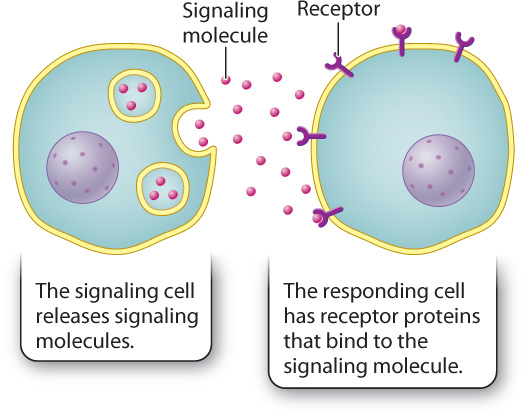9.1 PRINCIPLES OF CELL COMMUNICATION
As members of our own communities, we often base our actions on information we receive from others in the group, responding very differently to a friendly handshake or affectionate hug than to a hard shove or violent blow. We also glean information from inanimate things around us: We respond differently when we walk barefoot on hot pavement than when we take a seat in a comfortable chair. Similarly, the activities of virtually all cells are influenced by their physical surroundings, including interactions with other members of the community of cells. Cells receive large amounts of information from their surroundings, from numerous sources and in different ways. Often, information is conveyed from one cell to another in the form of small molecules secreted into the environment. Other information is provided by physical contact with neighboring cells. Still other information is provided by the meshwork of proteins and polysaccharides that underlies or surrounds most cells in multicellular organisms (Chapter 10).
In this section, we take a look at general principles of cell communication, including how cells send and receive signals and how a cell responds after it receives a signal. These basic principles apply to all living organisms, both prokaryotes and eukaryotes, and both unicellular and multicellular organisms.
9.1.1 Cells communicate using chemical signals that bind to specific receptors.
An example from prokaryotes illustrates some important principles underlying cell communication. Streptococcus pneumoniae (also known as pneumococcus) is a disease-causing bacterium that is associated not only with pneumonia but also with meningitis and some kinds of arthritis. Many bacteria, including pneumococcus, are able to take up DNA from the environment and incorporate it into their own genome. By this means, individual bacterial cells can share genes with advantageous properties, including the ability to resist antibiotic drugs.

In the 1960s, it was observed that the rate of DNA uptake by pneumococcal cells increased sharply once the bacterial population reached a certain density. Scientists concluded that the bacteria were able to coordinate DNA uptake across the population so that uptake occurred only at the appropriate time. How is it possible that these bacteria “know” how many other bacteria are present and are able to communicate this information to one another?
In the 1990s, scientists discovered a peptide consisting of 17 amino acids that is continuously synthesized and released by pneumococcal cells. Not long after, a receptor for this peptide was discovered on the surface of the pneumococcal cells. The binding of this peptide to its receptor causes a bacterium to express the genes required for DNA uptake. When the bacteria are at low density, the concentration of the peptide is too low to activate the genes required for DNA uptake (Fig. 9.1a). As the population density increases, so does the concentration of the peptide, until it reaches a level high enough to cause the cells to turn on the genes necessary for DNA uptake (Fig. 9.1b).
This simple example of DNA uptake by pneumococcus illustrates the four essential elements involved in communication between all cells, whether prokaryotic or, as shown in Fig. 9.2, eukaryotic. These elements are a signaling cell, a signaling molecule, a receptor molecule, and a responding cell. The signaling cell is the source of the signaling molecule, which binds to a receptor molecule on or in the responding cell. In the case of pneumococcus, the bacterial cells are both the signaling cells and the responding cells. In other cases, the signaling and responding cells may be different cells. Nevertheless, the general idea that cells are able to communicate by sending a signaling molecule that binds to a receptor on a responding cell is universal among both prokaryotes and eukaryotes. These four players interact in very much the same way in diverse types of cellular communication.

9.1.2 Signaling involves receptor activation, signal transduction, response, and termination.
What happens after a signaling molecule binds to a receptor on a responding cell? On binding the signal, the receptor is turned on, or activated (Fig. 9.3). Once activated, the receptor transmits the message through the cytoplasm, often by intracellular signaling pathways or cascades, in a process called signal transduction. The message is carried from outside the cell into the cytosol or nucleus. Along the way, the initial signal is often amplified, so that a small signal can have a large effect on the responding cell.

Next, there is a cellular response, which can take different forms depending on the nature of the signal and the type of responding cell. For example, signaling pathways can activate enzymes or turn on genes that cause the cell to divide, change shape, or signal other cells. Finally, the signal is terminated. Termination allows the cell to respond to new signals.
In the case of pneumococcal cells, the peptide-signaling molecule binds to a receptor on the cell surface. When enough receptors are bound by the signaling molecule, the message is relayed by signal-transduction pathways to the nucleoid in the cytosol, where genes are turned on that express proteins involved in DNA uptake from the environment. Eventually, when the density of bacteria is low, the initiating signal falls below a critical threshold and gene expression is turned back off. This example is relatively simple. Remarkably, however, other signaling pathways in a wide range of organisms involve the same four players and a common series of steps, which have been evolutionarily conserved over long periods of time.